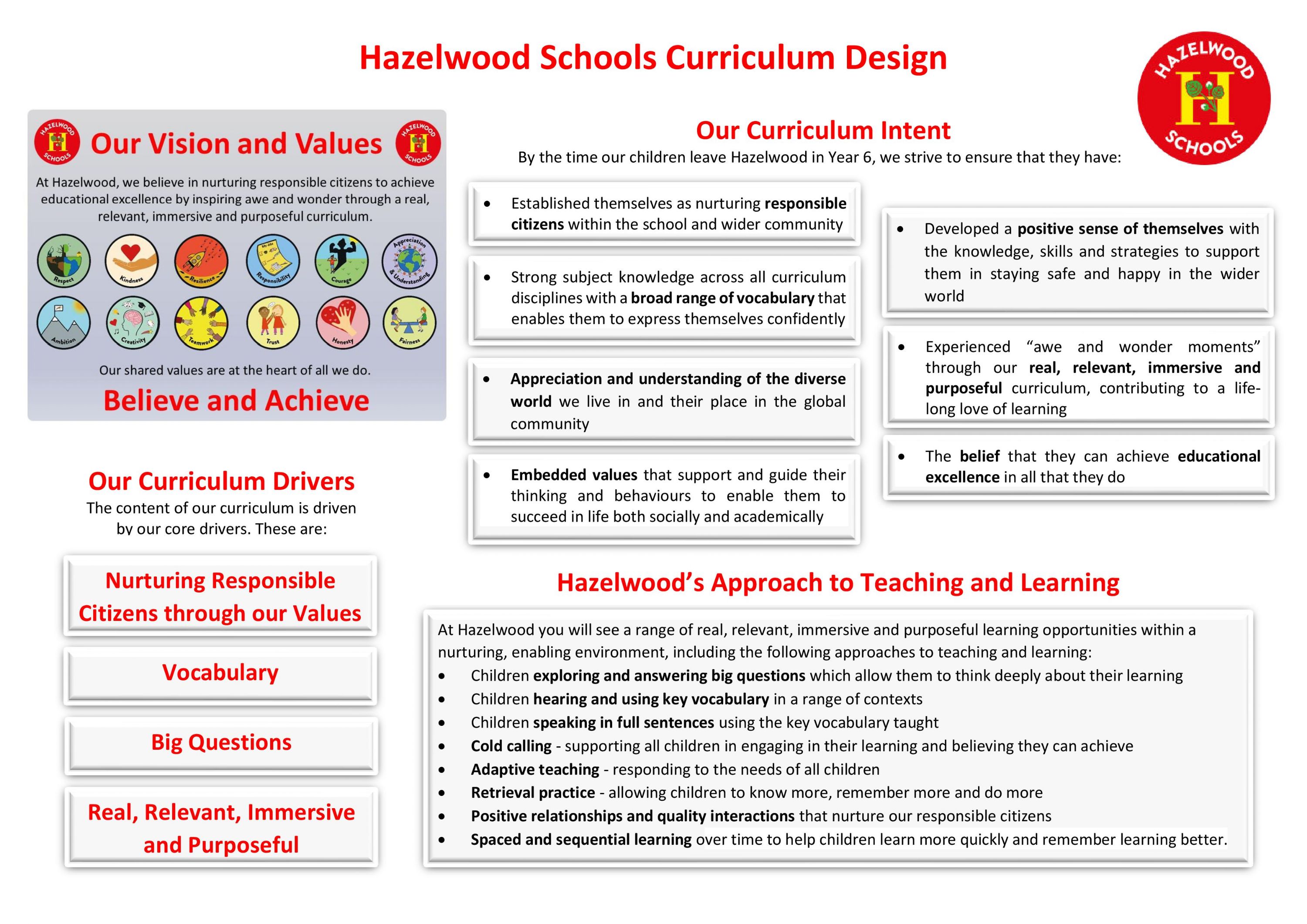The Hazelwood Curriculum
At Hazelwood Schools, our curriculum intent is designed using our Vision and Values as a springboard for what we want our children to achieve and experience by the time they leave Year 6. From this, we have identified our key curriculum drivers and outlined our approach to teaching and learning.

Our Curriculum Drivers Explained
Nurturing Responsible Citizens through our Values
At Hazelwood, nurturing responsible citizens means developing children who live by our embedded values of: respect, kindness, resilience, ambition, creativity, teamwork, responsibility, courage, appreciate & understanding, trust, honesty and fairness. This driver supports personal development and social responsibility, preparing children to contribute positively to our school and wider community.
At Hazelwood, children participate in community action projects such as visiting the local care home, reading to younger children in the local library and planting & delivering daffodils to local business on the high street. As a school, we take part in numerous charity fundraisers, explaining to the children the importance of demonstrating responsibility and kindness for others.
When conflicts arise, as part of our positive behaviour policy, staff will use restorative and reflective conversations rooted in values like honesty and fairness to resolve issues constructively.
Our values are interwoven into our curriculum, assemblies, classroom charters, leadership responsibilities and daily routines. Our children develop a sense of pride and the ability to articulate their feelings about key issues and how to live by our values.
Vocabulary
At Hazelwood, we believe that explicit vocabulary teaching is essential in order to give our children the opportunity to achieve educational excellent and to become responsible citizens of the future. A rich vocabulary supports comprehension, critical thinking and confident communication across academic subjects as well as for conversations with peers and adults. A broad range of vocabulary enables our children to express themselves confidently and effectively.
As a school, we focus on the pre-teaching of vocabulary. Rather than ask children to guess answers and key words before new topic, teachers will share key words with visuals and explanations.
Within the classrooms, displays will contain subject-specific words that are regularly referred to and updated.
Structured talk partners (used through ‘think, pair, share’) encourage children to use new vocabulary repeatedly so that it becomes embedded and familiar.
Staff will use a variety of approaches (pictures, actions, objects) to teach new vocabulary, and encourage children to explain meanings and use words in context.
Teachers will regularly assess vocabulary acquisition and learning is adapted accordingly. Our children are given many opportunities to retrieve and embed new vocabulary.
Big Questions
Big Questions foster curiosity, critical thinking, and deeper engagement in learning by encouraging children to explore ‘why’ and ‘how’ beyond the basic factual recall.
Teachers use Big Questions as wide reaching entry points to units of work, revisiting them regularly throughout the learning. In turn, these questions, encourage children to generate their own questions and hypotheses. Teachers will structure lessons to build knowledge that answers these questions progressively and use reflection opportunities for children to express their developing understanding.
Examples of big questions:
In History, a Big Question might be “Why do we remember important people from the past?” prompting children to think about legacy and values.
Science: “How do plants and animals depend on each other?” encourages children to investigate ecosystems.
Big Questions can connect subjects, e.g., linking Geography and Art with “How does where we live influence what we create?”
Answering big questions enable our children the opportunity to communicate what they have learnt effectively and think like a Historian/ Scientist/ Artist etc.
Real, Relevant, Immersive and Purposeful
A curriculum that is real, relevant, immersive and purposeful, connects learning to children’s lives and the wider world, making it more engaging and appropriate for all learners contributing to a life-long love of learning. At Hazelwood, we know that these Immersive experiences deepen understanding and motivation to learn, as well as provide memorable experiences that our children will cherish.
At Hazelwood, we think carefully about the cultural capital and enriching opportunities our children receive in order to ensure an all-round, balanced curriculum, knowing that our children learn and enjoy learning in different ways. Our children visit local parks, museums, places of worship and historical sites to experience learning first hand. We invite local professionals (e.g. firefighters, dentists) to talk about their roles’, linking learning to real-world careers.
All children take part in the community action plan throughout their time at Hazelwood, building links with the local community in a meaningful context.
Teachers and subject leaders plan the curriculum carefully to incorporate visits, visitors, and hands-on activities. They use real-life problems and scenarios for children to think about and solve collaboratively. They ensure curriculum content reflects children’s cultural backgrounds and experiences, as well as provide them with new ones.
At Hazelwood, we provide opportunities for outdoor learning through our Forest School sessions.
Please click on the subject below to see our curriculum intent, overviews and knowledge and skills progression for each subject.
